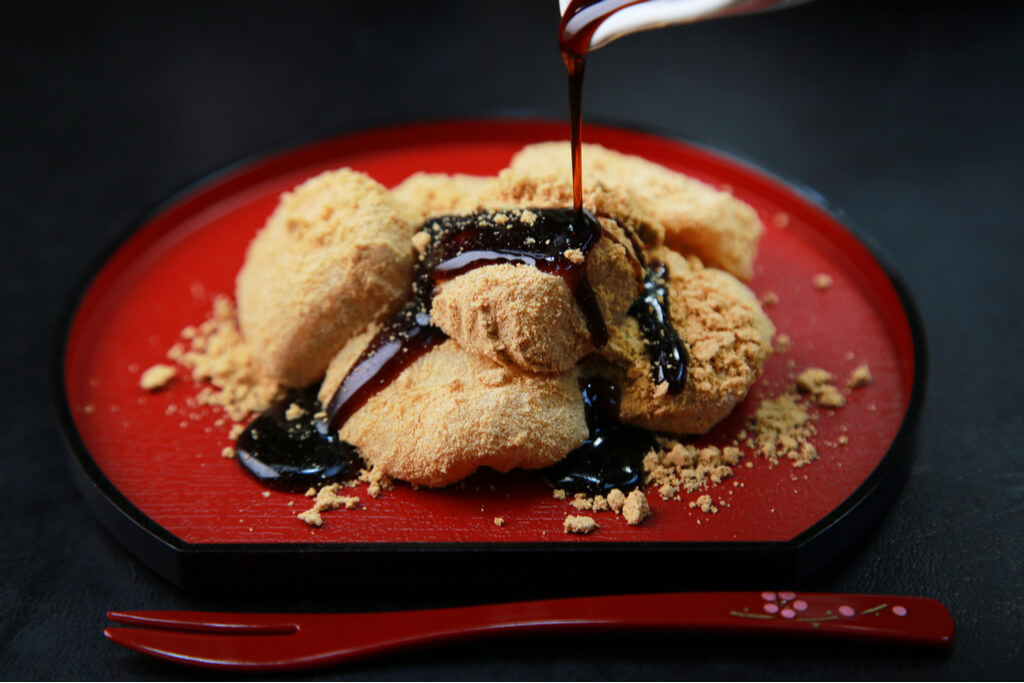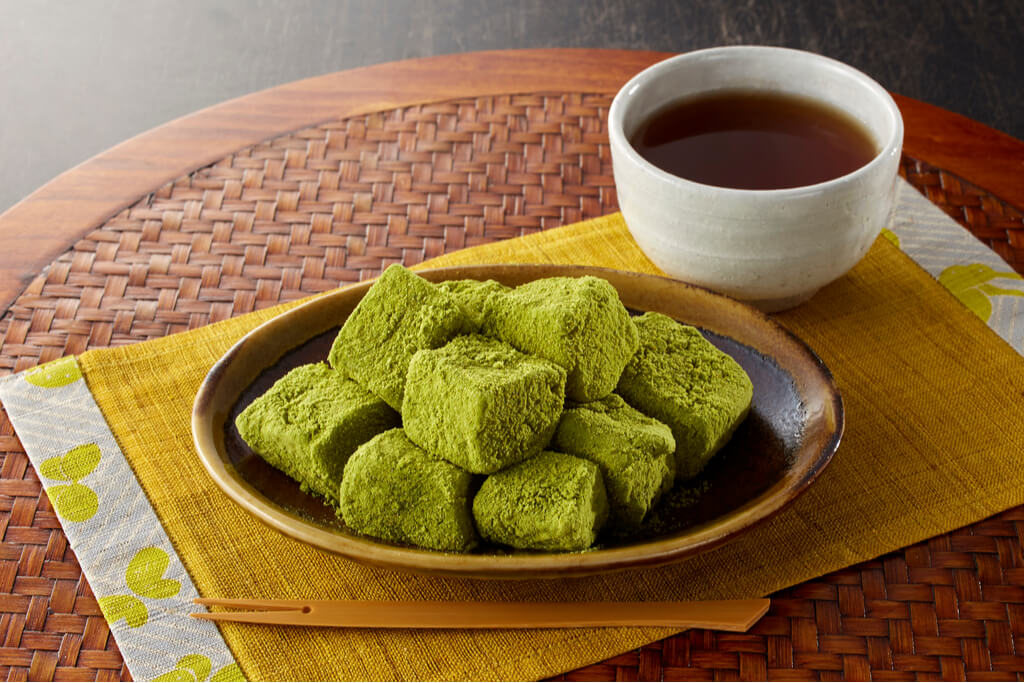Warabi Mochi: The Perfect Japanese Summer Treat
Tanner Schroeder
Posted on July 06, 2021
Share:

Even though warabi mochi has a similar name to the glutinous rice paste “mochi” used to make other Japanese sweets, warabi mochi is very different from regular mochi.
What is Warabi Mochi?
Warabi mochi is a cool, jelly-like dessert, especially popular during Japan’s humid summer months. It is a kind of wagashi (traditional Japanese sweets), with a history dating back to the Heian era (794-1185). Warabi mochi gets its name from the “warabi” fern, as the jelly is made with starch from the fern’s roots.
Regular mochi is a thick paste, which can be molded into balls to make sweets like daifuku, or dango. However, warabi mochi has a much softer, gel-like texture. Mochi is also white after cooking, while warabi mochi is translucent in appearance.
Warabi mochi is sweet from the sugar added during the cooking process, but otherwise does not have much flavor. In fact, warabi mochi has a similar taste to unflavored tapioca pearls, as they are both made from the starch of tubers. While the flavor mainly comes from the additional toppings it is served with, the mochi’s texture is key. The jelly texture of properly-made warabi mochi is so soft that it melts in your mouth.
How is Warabi Mochi Typically Enjoyed?
In the Kansai region and Okinawa, this special mochi is a cool summer snack. The jelly is sprinkled with kinako (roasted soybean powder, with a taste reminiscent of peanut butter), drizzled with kuromitsu (black sugar syrup), and served chilled. The added nutty flavor of the soybean powder and sweetness of the black sugar pair perfectly with this cool jelly. Sometimes, the warabi mochi is stuffed with red bean paste for another layer of flavor and texture. In the Eastern and Northern regions of Japan, warabi mochi can also be served hot, in a sweet soup with the black sugar syrup.
You can buy warabi mochi at wagashi-ya (traditional Japanese sweets stores), cafes serving traditional sweets, and even convenience stores, which carry warabi mochi cups in their refrigerated desserts section.
How to Make Warabi Mochi
The most difficult part of making warabi mochi is finding the warabi starch, as it is an ingredient usually only used in Japanese cooking. There are two types of warabi starch:
Hon warabiko (which translates to “real” warabi flour) is made of 100% starch harvested from the warabi fern plant. Unfortunately, it is very difficult to harvest the starch, as only 5 percent of the roots of the fern gets processed into starch. Then, turning this starch into a powder is another lengthy process. This means that actual hon warabi is quite expensive and difficult to buy. While you can purchase it online, the sale of warabi starch online is not very well regulated. Some starches with the name hon warabiko may actually be a mixture of starch from warabi and other plants.

The other kind of starch, which may be purchased online or at some Asian grocery stores outside of Japan, is called warabi mochiko. This powder, although similar in appearance to hon warabiko, is usually made of sweet potato starch, tapioca starch, or kudzu arrowroot starch.
Recipe
- 100g Warabi starch (either hon warabiko, or potato starch)
- 100g sugar (can be reduced if you prefer a less sweet version)
- 400ml water
- Kinako soybean powder
- Kuromitsu syrup to taste (see recipe below to make your own syrup)
- Powder a baking sheet with the kinako soybean powder and set aside.
- Mix warabi starch, water, and sugar in a medium saucepan.
- Bring the mixture to a boil over medium heat.
- Once the mixture begins to boil, turn the heat to low. Beat the mixture with a spatula for around 10 minutes or so, until it turns from white to translucent and thickens, becoming a “mochi” paste. Once the paste is fully translucent, take it off the heat.
- Spread the mochi onto the kinako-dusted baking sheet, into a layer about 2 cm thick. Sprinkle more kinako powder onto the top of the mochi. Refrigerate the baking sheet for 20 minutes.
- After cooling, slice the mochi into 2 cm cubes, plate, and pour on the kuromitsu syrup.

Do not refrigerate the mochi for long periods of time, as it will harden. At room temperature, it can last one or two days but is best enjoyed as soon as possible. Before eating, refrigerate the mochi for 20 minutes or so.
To make your own kuromitsu syrup, you can follow this recipe. Also, if you live in the US, molasses makes a good substitute, even if the flavor is slightly different.
Kuromitsu Syrup Recipe:
- 100g Black Sugar
- 100g Sugar
- 100ml water
Boil water and sugar over medium heat, stirring to allow the sugar to dissolve. Reduce the heat to low and simmer for about 20 minutes, until the mixture has a syrupy consistency. Once cooled, your syrup is ready to be served! It can be stored in an airtight container in the refrigerator for about a week.

Discover authentic flavors with Sakuraco
Get Sakuraco 

Discover authentic flavors with Sakuraco
Get Sakuraco 
Related Articles

Steam Train in Shizuoka: Riding the Oigawa Railway
For travelers who love history, beautiful views, and cozy retro vibes, this steam train is one of Shizuoka’s most charming treasures, with some of the best views. If you want to know more about this train, keep reading below!

Nara Japan: The Amazing Legend of the Sacred Dragon
In Japanese culture, dragons are spiritual beings that represent strength, prosperity, and a harmonious balance with the natural forces. Nara, Japan, has a unique story associated with sacred ponds and revered shrines throughout the region.

Nambu Tekki: Morioka’s Amazing Iron Craft
In the historic city of Morioka, Iwate Prefecture, a craft with over 400 years of history continues to captivate with its rustic beauty and practical charm. Nambu tekki, or Nambu cast iron, refers to traditional ironware, such as teapots, kettles, and decorative pieces, that embody the spirit of Tohoku craftsmanship.

Ebisu: The Cheerful Guardian of Luck and Prosperity
Religion in Japan involves a dizzying array of spirits and beings. These gods are inspired by ancient tales and used to symbolize nature’s bounty. However, they also profoundly impact daily life and are often sought out for help in challenging times


